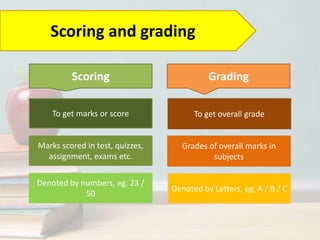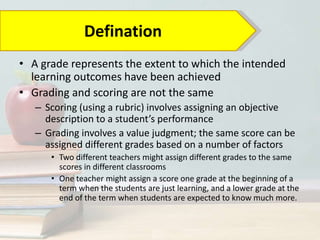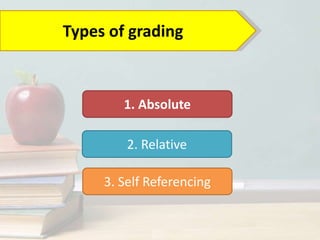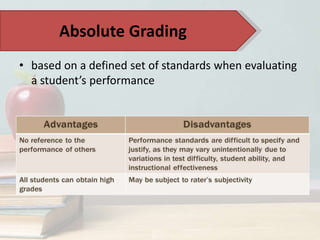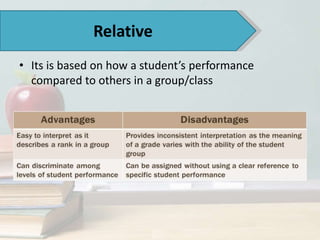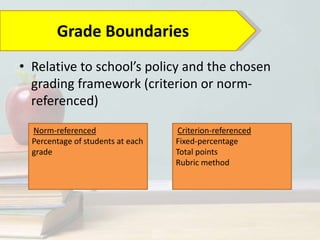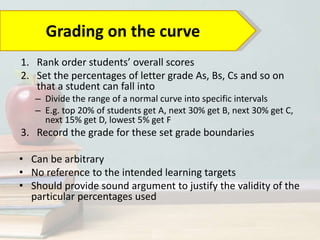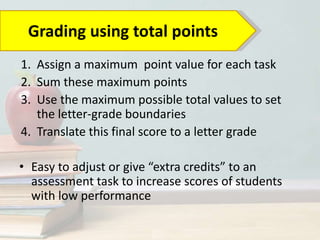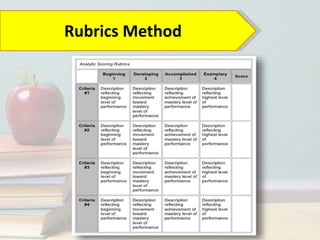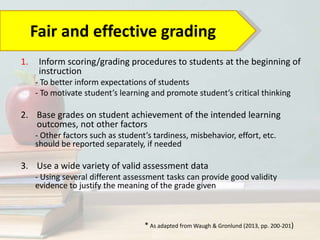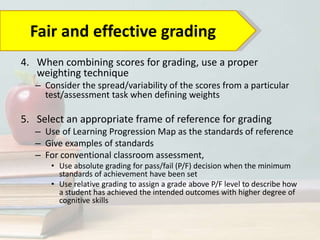Scoring and grading ppt
- 1. Scoring and Grading M Shoaib GH www.talenthiker.com
- 2. âĒ Scoring and Grading âĒ Definitions of grading âĒ Types of grading framework âĒ Defining grade boundaries âĒ Fair and Effective grading Content
- 3. Scoring and grading To get marks or score To get overall grade Marks scored in test, quizzes, assignment, exams etc. Grades of overall marks in subjects Denoted by numbers, eg. 23 / 50 Denoted by Letters, eg. A / B / C Scoring Grading
- 4. âĒ A grade represents the extent to which the intended learning outcomes have been achieved âĒ Grading and scoring are not the same â Scoring (using a rubric) involves assigning an objective description to a studentâs performance â Grading involves a value judgment; the same score can be assigned different grades based on a number of factors âĒ Two different teachers might assign different grades to the same scores in different classrooms âĒ One teacher might assign a score one grade at the beginning of a term when the students are just learning, and a lower grade at the end of the term when students are expected to know much more. Defination
- 5. Types of grading 1. Absolute 2. Relative 3. Self Referencing
- 6. âĒ based on a defined set of standards when evaluating a studentâs performance Absolute Grading
- 7. âĒ Its is based on how a studentâs performance compared to others in a group/class Relative
- 8. âĒ It is based on the teacherâs/raterâs perspectives of improvement, growth, or change that a particular student has performed in comparison with his/her prior learning. Self Referencing
- 9. âĒ Relative to schoolâs policy and the chosen grading framework (criterion or norm- referenced) Grade Boundaries Criterion-referenced Fixed-percentage Total points Rubric method Norm-referenced Percentage of students at each grade
- 10. 1. Rank order studentsâ overall scores 2. Set the percentages of letter grade As, Bs, Cs and so on that a student can fall into â Divide the range of a normal curve into specific intervals â E.g. top 20% of students get A, next 30% get B, next 30% get C, next 15% get D, lowest 5% get F 3. Record the grade for these set grade boundaries âĒ Can be arbitrary âĒ No reference to the intended learning targets âĒ Should provide sound argument to justify the validity of the particular percentages used Grading on the curve
- 11. 1. Give a percentage correct score for each student for each task 2. Multiply each taskâs percentage by its corresponding weight and add these products together 3. Divide the sum of products by the sum of weights to get a composite percentage score 4. Translate this final score to letter grade âĒ Relationship between percentage correct and letter grade is arbitrary ï follow school policy âĒ This method may encourage us to focus more on the task difficulty than on the intended learning outcomes. Grading using fixed percentage
- 12. 1. Assign a maximum point value for each task 2. Sum these maximum points 3. Use the maximum possible total values to set the letter-grade boundaries 4. Translate this final score to a letter grade âĒ Easy to adjust or give âextra creditsâ to an assessment task to increase scores of students with low performance Grading using total points
- 13. âĒ Assign an ordered number to each level of rubrics. â Higher number represents a higher complexity âĒ Summing across components âĒ Calculate the sum or the average of the numbers, or use fixed percentage method â Care is needed to avoid grade distortion (e.g. 3 on a 4-point rubric is 75%; converting this to a grade of C may not make sense) Grading using Rubrics Method
- 14. Rubrics Method
- 15. 1. Inform scoring/grading procedures to students at the beginning of instruction - To better inform expectations of students - To motivate studentâs learning and promote studentâs critical thinking 2. Base grades on student achievement of the intended learning outcomes, not other factors - Other factors such as studentâs tardiness, misbehavior, effort, etc. should be reported separately, if needed 3. Use a wide variety of valid assessment data - Using several different assessment tasks can provide good validity evidence to justify the meaning of the grade given Fair and effective grading * As adapted from Waugh & Gronlund (2013, pp. 200-201)
- 16. 4. When combining scores for grading, use a proper weighting technique â Consider the spread/variability of the scores from a particular test/assessment task when defining weights 5. Select an appropriate frame of reference for grading â Use of Learning Progression Map as the standards of reference â Give examples of standards â For conventional classroom assessment, âĒ Use absolute grading for pass/fail (P/F) decision when the minimum standards of achievement have been set âĒ Use relative grading to assign a grade above P/F level to describe how a student has achieved the intended outcomes with higher degree of cognitive skills Fair and effective grading
- 17. 6. Review borderline cases by reexamining all achievement evidence â Re-evaluate the borderline studentâs performance in all assessment tasks given â Favor a higher grade â Cautions of giving a Failing grade (F): âĒ Given to a student who consistently performs below the minimum standards of achievement âĒ Notion of measurement error of an observed score Fair and effective grading * As adapt from Waugh & Gronlund (2013, pp. 200-201)
- 18. Suggest to improve May Allah enlighten us to reflect effectively


